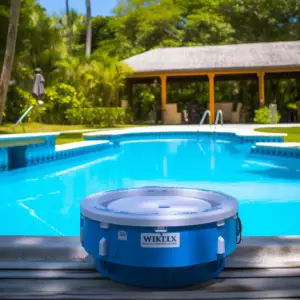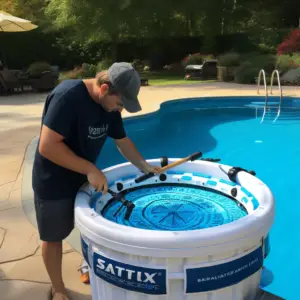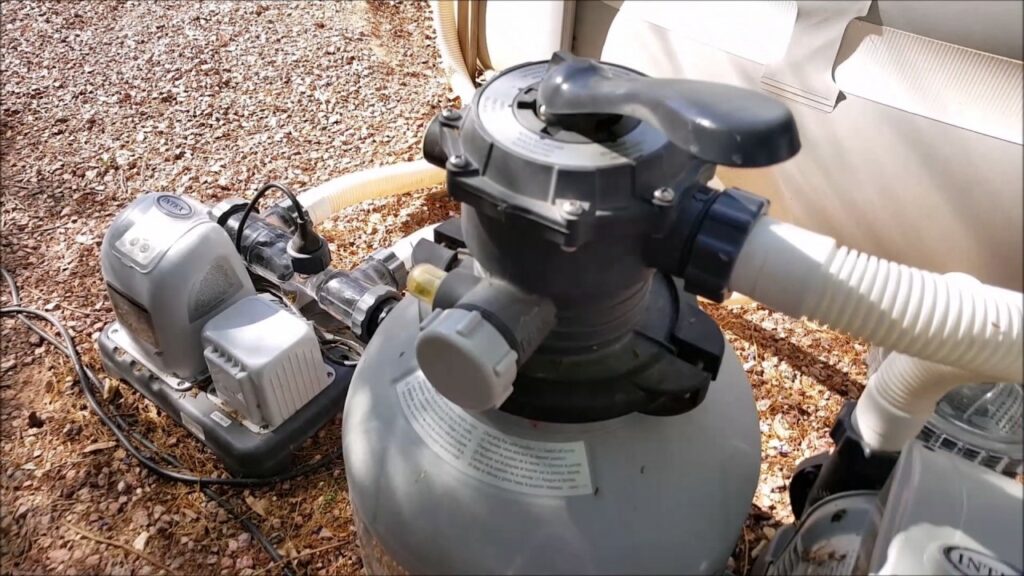Intex Saltwater Systems is a popular chlorinator meant for use with above-ground pools. The system is easy to install and use, and when it is working properly, it can maintain the required chlorine level by electrolyzing salt in the water.
Although the system has good reviews in general, some people have reported problems with faulty error codes indicating too low or too much salt in the water. This brings us to one of the most common questions; why does the Intex Saltwater system keep saying low salt?
One thing to note about the Intex saltwater system is that the pool pump filter is so small that if it is not cleaned out several times a day, it can get clogged and significantly decrease the water flow.
This, in turn, causes a low reading and low chlorine output due to the fact that the water is not moving quickly and strong enough through the Saltwater System.
Table of Contents
Why Does My Intex Saltwater System Keep Saying Low Salt?

The Ideal Salt Level
The ideal salt level in the pool water is between 2500-3500 parts per million (ppm) with 300 ppm being optional. If the salt level is too low, it will reduce the efficiency of the Saltwater System, which will cause low chlorine production.
However, before adding salt to your pool, ensure the water is tested to determine the salt level. This will help to prevent adding too much. For instance, if you’re at the minimal level of slat (or zero ppm) adding 25 lbs per 2,000 gallons, you should get to 1500 ppm of salt. Some consumers have reported feeling the befits of just adding salt at around 1000 ppm too.
The easiest way to know whether the chlorinator is working is by checking the needle or production lights and keeping the cell clean. Besides, there should be a light or dial on the chlorinator box that shows it’s working.
Speaking of the cell, Intex Saltwater Systems is important to make sure it does the best job as well. If the cell bubbles vigorously, then it is working fine. However, if the salt cell bubbles, but only a little bit, you might be having a bad cell. You might need to call a pool professional to confirm this diagnosis.
There are various reasons that can cause a salt cell to fail. One of the main reasons is the lack of proper maintenance. It is highly recommended to inspect the cell regularly for excessive build-up. This will help to make sure excess calcium doesn’t become caked on the metallic plates. The next common cause of salt cell failure is improper water balance.
It’s good to note that there are several reasons that can cause a salt cell not to produce chlorine. For instance, if the Stabilizer is too low, this will affect the ability of the pool water to hold the chlorine being produced. Also, a low pH level will oxidize chlorine faster, making it hard to maintain the proper level of chlorine.
Problems with Intex Saltwater Chlorinators
Calcium Buildup on the Plates
The electrolytic chlorine generation produces calcium scales as a by-product. This, in turn, can quickly build up in the electrolytic cell. The resultant build-up can bring about a number of error codes.
If you want to clean the cells, the manufacturer recommends removing them and either washing them off with a garden hose or placing them in a vinegar solution overnight. The suggested solution consists of one cup of vinegar and 2 gallons of water.
Codes 92 & 92
The LED display in the Intex chlorinator can show various error codes, with the most common ones being 21 and 92. Code 91 means that the salt level is too low while Code 92 indicates that it’s too high.
That said, whenever you see these codes, it’s highly recommended to test the water before doing anything else as the code may be an error. If the slat level is indeed too low, add slat according to the pool volume as well as the amount you need to raise the level.
If the level is too high, the only solution is to drain some of the water out of the pool and replace it with fresh water. The manufacturer suggests that you drain 20% of the water. When you see Code 91 and you find that the salt concentration is correct, then it means the electrolyte cell needs maintenance.
You might want to remove it and immerse it in vinegar to clean off the scale. You will have to seek professional attention if there’s any malfunction after doing this, because the cell may be faulty.
Code 90
A Code 90 error message indicates that insufficient water is flowing through the generator. This may be due to one or more valves being closed when they should be open. Still, it can also indicate a clogged filter.
If the issue persists, even after inspecting the valves and making sure all lines are well attached, and cleaning the filter, then the problem could be the airlock. To resolve this, spray pressurized water through the system to clear it.
Intex Saltwater Systems still getting the Code 90, then the sensor may be caked with calcium deposits, or it may need to be replaced.
Cooper Staining
The fact that electrolyte plates are made from copper, means that they release copper ions into the water. On the bright side, this is a good thing given that copper kills algae. However, on the flip side, too much of a good thing can stain the pool. Copper ion concentration should be below 0.2 ppm.
You can add aluminum sulfate to bring it down should it get any higher, but in extreme cases, you might want to drain 20% of the water and replace it. The copper stains can be cleaned with vinegar or lemon juice. Avoid aggressive cleaners and scrubbing that may etch pool surfaces.
Chlorinator Says Low Salt
The Intex salt water chlorinator for above-ground pools is a simple system to install and operate. With proper functioning, salt is electrolyzed in the water to keep the required chlorine levels.
However, there are complaints about inaccurate error signals showing either too much or too low salt in the water and faults caused by scale buildup on the electrolysis plates. So, what does it mean when the chlorinator says low salt?
The chlorinator consists of a control panel that displays various error codes, which calls for action to test the water before progressing.
Therefore, a low salt warning indicates that the pool’s salt level is shallow (below 2000ppm and 3500ppm) for the chlorinator to produce chlorine. As a result, less chlorine output will lead to improper sanitization and a murky pool if unchecked.
Intex Low Salt Error
A low salt level warning might be a glitch. Therefore, Intex Saltwater Systems would be best first to test the salt level to confirm. Add more salt to the pool if you have a low salt error.
Purchase a bag of Sodium chloride salt, then add the right amount of salt to the pool, which ranges between 2500-4000 ppm. But it is advisable to read the salt water generator guidelines.
Next, leave the pump on for at least 12 hours to circulate the water before retesting the salinity of the water. The “low salt” warning light should be off with the proper salt levels.
Cleaning Intex Salt Cell
The most common challenge for salt pool owners is scale buildup which, if unnoticed, will reduce the effectiveness and even further reduce the cell’s lifespan. Therefore, it is paramount to maintain a clean salt cell to ensure continuous chlorine production.
How frequently you clean and maintain your salt cell depends on pool use, water hardness, pool chemistry, and the salt cell age.
Before taking you through the steps of how to clean a salt cell, here is a snippet of what causes the scale buildup:
Heat- when the temperatures are hotter, more calcium tends to drop out of the pool chemicals solutions and form a deposit across the electrolytic plates within the generator cell, reducing its ability to produce chlorine.
As the scale accumulates, forcing the salt cell to work harder and hotter to continue producing chlorine triggers future scale up and shortens the cell’s lifespan.
High pH
pH results from the generator converting salt into chlorine. Scaling may form around the pool surface and equipment if not maintained. So, keeping the pool water in balance is essential.
A clean salt cell works better and lasts longer. Here are easy steps on how to clean a salt cell:
- Turn off the pool pump- unplug the chlorine generator and turn off the circuit breaker for the pool pump
- Gradually unscrew the unions to ease pressure on the lines and remove the cell for cleaning
- Look for deposits- The cell requires cleaning if it has mineral deposits on its filters. The white, dry, and flaky stakes decrease the unit’s efficiency. If it is clean, fix it back and check after a month.
Physical Method- Garden Hose

For mild calcium deposits and loose pieces, use a garden hose. Project it in one end of the unit, allowing the water to go through it and flow out to the other end while keeping the plug end dry
Chemical Cleaning
Practice safety measures like using rubber gloves and safety goggles to protect yourself from the effects of the chemical. Also, clean the cell with enough ventilation to avoid inhaling the fumes.
- Pour one gallon of water into a clean bucket and add one quart of muriatic acid. Remember to add the acid to water and not water to acid.
- Secure the generator cell to the cleaning stand, and pour the diluted muriatic acid in through the top, completely covering the plates but don’t overfill them. Intex Saltwater Systems the acid starts to bubble, it is a sign that it is working.
- Let the cell soak for about 15 minutes. As time elapses, bubbles coming off the deposits will gradually slow and come to a stop. When there are no bubbles, it means the chemical has done its work.
- Pour the acid mixture back into the mixing bucket. Re-examine the electrolytic plates and repeat the soaking step if some deposits are present.
- Finally, once the cell is clean, thoroughly rinse it out with water and reconnect it to the pool lines.
- Plug in the generator cell, restore power to the pool pump, and let the pump prime.
Intex Salt Cell Not Working
The salt generator uses electrolysis in the dissolved salt to produce sanitizing agents for swimming pools. Despite the system requiring minimal maintenance to its counterparts, it may develop issues leading to its malfunctioning.
Signs of a malfunctioned salt cell:
- Low chlorine levels in the water
- Corroded plates
- Lights signaling cell damage
- No flow indication on the flow monitor
Intex Saltwater Systems stops working, there is insufficient chlorine production to meet the pool needs. And in turn, the pool water turns dirty, leading to poor sanitation, corrosion in some parts of the pool, and algae formation.
Intex Error Code 90 Low Pump Flow
A message indicates insufficient water flow through the generator due to one or more valves being closed when they should be. It can also mean a clogged filter. To troubleshoot the issue, check the valves to ensure all the lines are correctly attached and clean the filters.
Intex Saltwater Systems the error persists, there would be an airlock and spray of pressurized water through the system to clear it. Still, getting code 90? The sensor may be loose, deposited with calcium minerals, or it may need a replacement.
Ace Saltwater System Problems
Calcium Buildup on the Plates
The electrolytic chlorine generator generates calcium scales as a by-product. It quickly builds up in the electrolytic cell. As a result, several error codes are experienced, with the most common being:
- Code 92
- Code 90
- Code91
- Copper staining
- Insufficient chlorine sanitization
Each with its symptoms and ways you can fix them.
FAQs
Does the Intex saltwater system work?
It produces chlorine for swimming pools through additional salt to the pool’s water without using costly, toxic chemicals to keep it sanitized. Upon salt dissolving in the water, the pump circulates it through a chlorine generator that separates the sodium chloride in the water, generating chlorine.
How long should I run my Intex saltwater system?
Run the water system for at least 9 hours, but the recommended time is 12 hours.
What kind of salt do you use for the Intex saltwater system?
Only sodium chloride (NaCl) salt, at least 99.8%, is allowed for such a system. Alternatively, you use water conditioning salt pellets, although they will take a long time to dissolve.
How long does an Intex saltwater system last?
The average lifespan of a salt cell is 5 years when running it at an average of 6 hours daily.
How long should I run my Intex salt chlorinator?
First, run the filter pump for at least six hours to ensure the added salt has entirely dissolved. Now you can run the salt water system as recommended in the manual, which is at least 12 hours or twice a day.


